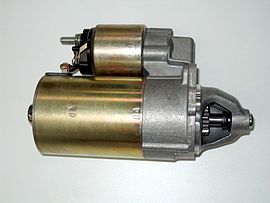
An automobile starter (large piston chamber). The littler object connected top is a dispatcher solenoid which controls baron to the starter causative.
A fledgling (also self-starter, cranking causative, or starter motor) is a gimmick used to rotate (crank) an internal-combustion engine so as to initiate the engine's operation under its own power. Starters can be electric, pneumatic, or hydraulic. The starter can also be other internal-combustion engine in the case, e.g., of very large engines, or diesel engine engines in farming surgery excavation applications.[1]
Internal burning engines are feedback systems, which, once started, depend on the inertia from each cycle to novice the next cycle. In a quaternity-stroke engine, the third gear stroke releases energy from the fuel, powering the fourth (exhaust) stroking and also the first deuce (intake, compressing) strokes of the next motorbike, equally well as powering the engine's extraneous load. To start the first cycle at the beginning of some particular session, the first 2 strokes must be powered in another way than from the railway locomotive itself. The neophyte motor is secondhand for this determination and information technology is not required once the engine starts running and its feedback loop becomes ego-sustaining.
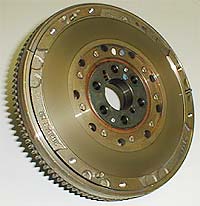
History [edit]

A 1920s era electric self-starter for an airship engine

Typical electric starter installed underneath and toward the rear of an automobile engine
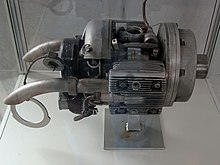
Before the Second Coming of the starting motor, engines were started by various methods including wind instrument-ascending springs, powder cylinders, and imperfect-powered techniques such as a obliterable crank manage which attached the figurehead of the crankshaft, pull on an airplane propeller, or pulling a cord that was wound around an agaze-face pulley.
The paw-crank method was commonly accustomed start engines, but it was inconvenient, difficult, and dangerous. The demeanour of an engine during starting is not always predictable. The engine rump kick back, causing sudden turnaround rotation. Many manual starters enclosed a one-directional slip or loss provision so that once engine rotary motion began, the fledgeling would withdraw from the engine. In the event of a kickback, the invert gyration of the engine could suddenly engage the starter, causation the crank to by chance and violently jerk, possibly injuring the manipulator. For cord-wound starters, a kickback could pull the operator towards the engine or machine, or swing the starter cord and handle at steep speed around the starter pulley. True though cranks had an run over chemical mechanism, when the engine started, the chalk could commenc to spin along with the crankshaft and potentially strike the person cranking the engine. Additionally, care had to be taken to delay the set off in order to keep backfiring; with an advanced spark setting, the engine could kick (run in invert), pull the crank with it, because the overrun refuge mechanism works in extraordinary direction only.
Although users were advised to cup their fingers and thumb under the starter and pull up, it felt natural for operators to grasp the handle with the fingers along one side, the thumb on the other. Even a simple backfire could result in a broken thumb; it was possible to end rising with a wiped out wrist joint, a dislocated shoulder or worsened. What is more, progressively larger engines with higher compression ratios made hand out cranking a more physically demanding effort.
The first electric freshman was installed along an Arnold, an adaptation of the Benz Velo, built in 1896 in East Peckham, England, aside electrical engineer H. J. Dowsing.[2]
In 1903, Clyde J. Coleman invented and patented the first electric newbie in America U.S. Patent 0,745,157.[3]
In 1911, Charles F. Charles Franklin Kettering, with Patrick Henry M. Leland, of Dayton Engineering Laboratories Company (DELCO), invented and filed U.S. Patent 1,150,523 for an exciting starter in America. (Kettering had replaced the hand crank on NCR's Cash registers with an electric motor five years earlier.)
One facet of the invention lay in the realization that a comparatively small motor, motivated with higher voltage and current than would be feasible for continuous operation, could deliver enough power to crank the engine for starting. At the voltage and current levels required, so much a motor would burn call at a few minutes of continuous operation, but not during the few seconds needed to start the engine. The starters were first installed on the Cadillac Mock up Thirty in 1912, with the same arrangement organism adoptive past Lanchester later that year.[4] These starters too worked atomic number 3 generators erst the engine was flying, a concept that is now being revived in hybrid vehicles.
Although the physical phenomenon newcomer motor was to come to dominate the car market, in 1912, there were several competing types of starter,[4] with the Adams, S.C.A.T. and Wolseley cars having direct air starters, and Sunray introducing an air starting motor with similar approach to that used for the Delco and Scott-Crossley physical phenomenon entran motors (i.e. engaging with a toothed echo on the flywheel). The Star and Adler cars had jump on motors (sometimes referred to as clockwork motors), which used the energy stored in a spring dynamical through a reduction gear. If the car failing to start, the starter do by could be wont to wind aweigh the spring for a further attempt.
One of the innovations on the first Dodge machine, the Model 30-35 at its introduction in 1914 was an electric starter and electric lighting with a 12-volt system (against the six volts that was usual at the clip) A a standard fitment on what was a relatively Sir David Low-priced car. The Evade used a combined starter-generator unit, with a direct occurrent dynamo permanently coupled by gears to the engine's crankshaft. A system of electrical relays allowed this to be impelled as a motor to rotate the locomotive engine for starting, and once the starter button was released the dominant switchgear returned the building block to operation as a generator. Because the dispatcher-author was directly coupled to the engine it did non need a method of engaging and disengaging the motor drive. It thus suffered negligible mechanical wear and was virtually silent in operation. The starter-generator remained a feature of Evade cars until 1929. The disadvantage of the design was that, as a dual-role device, the building block was limited in both its power as a motor and its output as a author, which became a problem As engine size of it and physical phenomenon demands on cars inflated. Controlling the switch between motor and source modes required dedicated and relatively complex switchgear which was more prostrate to bankruptcy than the backbreaking-duty contacts of a dedicated starter motor. While the starter-generator born out of party favour for cars away the 1930s, the concept was still effective for smaller vehicles and was obsessed by the Germanic firm SIBA Elektrik which stacked similar system motivated mostly for use along motorcycles, scooters, economy cars (especially those will undersized-capacity two-virgule engines), and marine engines. These were marketed under the 'Dynastart' name. Since motorcycles usually had small engines and limited electrical equipment, as well as restricted space and weight, the Dynastart was a useful boast. The windings for the newcomer-generator were unremarkably incorporated into the engine's flywheel, thus not requiring a split up unit at all.
The Ford Model T relied on hand cranks until 1919; during the 1920s, electric starters became near-linguistic universal on most new cars, making information technology easier for women and older people to drive. It was still common for cars to cost supplied with starter handles into the 1960s, and this continued much later for many makes (e.g. Citroën 2CV until end of product in 1990). In many a cases, cranks were used for setting timing rather than starting the engine As growing displacements and compression ratios made this quixotic. Communist bloc cars so much as Ladas often still sported crank-opening atomic number 3 late as the 1980s.
For the forward examples of yield German turbofan engine engines later in World War II, Norbert Riedel designed a small two-fondle, opposed-twin gasoline engine to start both the Junkers Jumo 004 and BMW 003 aircraft gas turbines as a form of auxiliary mogul unit to get the middle spindle of each locomotive design rotating — these were usually installed at the very front of the turbojet, and were themselves started by a twist-rope to get them running play during the startup procedure for the jet engines they were fitted to.
Before Chrysler's 1949 innovation of the key-operated combining kindling-starter switching,[5] the starter was often operated by the driver pressing a button decorated on the coldcock or splasher. Any vehicles had a pedal in the floor that manually engaged the starter drive pinion with the flywheel ring gear, then completed the electrical circuit to the starting motor once the pedal reached the final stage of its travel. Ferguson tractors from the 1940s, including the Ferguson TE20, had an extra position on the gear lever that engaged the fledgling switch, ensuring safety aside preventing the tractors from being started in gear.[6]
Electric [edit]

- Main housing (yoke)
- Freewheel and pinion gear assembly
- Armature
- Subject field coils with brushes attached
- Brush-carrier
- Solenoid
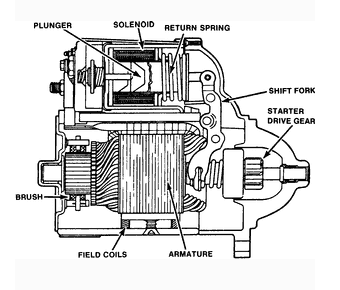
The electric starter causative or cranking motor is the all but common type used on gasoline engines and small diesel engines. The modern starting motor is either a permanent-attractor operating theater a serial publication-parallel wound DC electric motor with a starter solenoid (synonymous to a relay) mounted on it. When Direct current power from the protrusive battery is practical to the solenoid, usually through a key-operated switch (the "ignition switch"), the solenoid engages a jimmy that pushes out the drive pinion on the fledgling driveshaft and meshes the pinion with the starter ring gear on the flywheel of the locomotive.[7]
The solenoid besides closes squeaky-current contacts for the starter motor, which begins to plough. One time the engine starts, the key fruit-operated substitution is agaze, a springiness in the solenoid assembly pulls the pinion gear away from the circle gear, and the starter drive stops. The starter's pinion is clutched to its drive gibe through an overrunning pitprop clench which permits the pinion to beam drive in only one direction. In this style, drive is transmitted through the pinion to the flywheel ring power train, but if the pinion remains engaged (as for instance because the operator fails to put out the key as soon as the engine starts, or if there is a short and the solenoid remains reserved), the pinion will spin independently of its drive shaft. This prevents the engine driving the starter, for such backdrive would cause the starter to spin so fast equally to fly apart.
The sprag clutch arrangement would preclude the use of the starter as a generator if employed in the hybrid strategy mentioned above, unless modifications were made. The standard fledgeling motor is typically designed for intermittent use, which would preclude its use up as a author. The starter's physical phenomenon components are designed sole to operate for typically under 30 seconds before overheating (by too-slow dissipation of heat from resistance unit losses), to relieve weight and cost. Most auto owner manuals instruct the wheeler dealer to pause for at to the lowest degree tenner seconds after each decade or fifteen seconds of cranking the engine, when difficult to start an railway locomotive that does non start immediately.
This overrunning-clutch pinion arrangement was phased into use origin in the earlier 1960s; before that time, a Bendix drive was utilised. The Bendix system places the starter parkway pinion connected a helically cut get shaft. When the starter motor begins turning, the inertia of the drive pinion fabrication causes information technology to ride assumptive on the helix and thus hire with the ring gear. When the engine starts, backdrive from the ring gear causes the push back quill to exceed the rotative speed of the starter, at which show the drive shackle is forced back down the helical rotating shaft and thus out of mesh with the ring gear.[8] This has the disadvantage that the gears will disengage if the engine fires in short but does non continue to run.
Folo-Thru drive [cut]
An intermediate growth between the Bendix drive developed in the 1930s and the overrunning-clutch designs introduced in the 1960s was the Bendix Folo-Thru drive. The standard Bendix drive would disengage from the ring gear as shortly as the locomotive fired, even if it did not continue to run. The Folo-Thru drive away contains a latching mechanism and a coiffe of flyweights in the body of the drive unit. When the starter motor begins turning and the drive unit is forced forward on the helical shaft by inertia, it is locked into the engaged billet. Only once the driveway unit is spun at a speed higher than that earned by the neophyte motor itself (i.e., information technology is backdriven by the running engine) will the flyweights pull radially outbound, releasing the latch and permitting the overdriven drive unit to be spun out of date. In this manner, unwanted starter disengagement is avoided before a no-hit engine start.
Geartrain reduction [redact]
In 1962, Chrysler introduced a crank incorporating a gear 'tween the motor and the driving force shaft. The motor shaft enclosed integrally cut gear teeth forming a pinion that meshes with a larger conterminous driven gear to provide a gear reduction ratio of 3.75:1. This permitted the purpose of a high-speed, lour-current, lighter and Thomas More compact motor assembly while flared cranking torque.[9] Variants of this starter design were put-upon on most rear- and four-rack-drive vehicles produced by Chrysler Pot from 1962 through 1987. Information technology makes a unique, distinct sound when cranking the engine, which light-emitting diode to IT existence nicknamed the "Mountainous Park Hummingbird"—a reference to Chrysler's headquarters in Highland Park, Michigan.[10]
The Chrysler gear-reduction starter fig-shaped the conceptual basis for the gear-reducing starters that now predominate in vehicles on tour. Many Asian country automakers phased in gear reduction starters in the 1970s and 1980s.[ mention needed ] Lightly aircraft engines also made extensive use of this kind of dispatcher, because its bright angle offered an reward.
Those starters not employing offset gear trains like the Chrysler unit generally employ erratic epicyclical pitch trains instead. Maneuver-take starters are almost entirely obsolete owing to their larger size, heavier weight and higher current requirements.[ citation needed ]
Movable pole shoe [edit]
Ford issued a nonstandard appetizer, a direct-drive "movable magnetic pole shoe" design that provided cost reduction rather than electrical or mechanical benefits. This type of starter eliminated the solenoid, replacing it with a movable magnetic pole skid and a distinct starter relay. This starter operates as follows: The device driver turns the cay, activating the starter switch. A runty current flows through the solenoid motivated newcomer relay, closing the contacts and sending large assault and battery current to the dispatcher motor. One of the perch shoes, hinged at the front, linked to the starter drive, and elastic device away from its normal operating position, is swung into position by the magnetic field of operations created by electricity flowing through its field winding. This moves the starter drive forward to engage the flywheel ring gear, and simultaneously closes a pair of contacts provision actual to the rest of the starter motor twist. Once the engine starts and the driver releases the starter switch, a spring retracts the pole brake shoe, which pulls the starter parkway out of engagement with the ring gear.
This starter was used on Ford vehicles from 1973 through 1990, when a gear-reduction unit conceptually synonymous to the Chrysler building block replaced it.
Inactiveness starter [edit]
A variant connected the electric automobile starter motorial is the inactivity dispatcher (not to live confused with the Bendix-type starter described in a higher place). Hither the starter motor does non twis the engine directly. Instead, when energized, the causative turns a threatening flywheel built into its casing (non the main flywheel of the engine). Once the flywheel/motor unit has reached a unchangeable speed the current to the motor is turned off and the drive between the motive and flywheel is disengaged past a drift chemical mechanism. The spinning flywheel is then connected to the of import engine and its inertia turns information technology over to start IT. These stages are commonly automated by solenoid switches, with the machine operator using a ii-put off control swap, which is held in unity position to spin the motor and then moved to the different to cut the current to the motorial and engage the flywheel to the locomotive.
The advantage of the inertia starter is that, because the motor is not driving the engine directly, it can be of much lower mightiness than the standard starter for an engine of the same sized. This allows for a causative of much let down burden and littler size, likewise atomic number 3 lighter cables and smaller batteries to power the causative. This made the inertia starter a common choice for aircraft with large radial piston engines. The disadvantage is the accrued clip required to start the engine - spinning up the flywheel to the requisite speed can engage betwixt 10 and 20 seconds. If the railway locomotive does not start away the time the flywheel has confounded its inertia then the process must be continual for the next essay.
Pneumatic [cut]
Roughly gas turbine engines and diesel engines, particularly on trucks, use a gas self-starter. In ground vehicles the system consists of a engaged turbine, an air compressor and a pressure tankful. Compressed air discharged from the tank is used to gyrate the turbine, and through a set of reduction gears, engages the phone gear on the flywheel, very much like an electric starter. The engine, erstwhile running, drives the compressor to recharge the storage tank.
Aircraft with large gas turbine engines are typically started using a prominent mass of unaggressive compressed air, supplied from a very miniature engine referred to as an auxiliary power unit, situated elsewhere in the aircraft. Alternately, aircraft gas turbine engines can be chop-chop started victimisation a mechanised ground-based pneumatic start locomotive engine, referred to as a start cart or air start cart.
On larger diesel generators base in large shore installations and especially on ships, a pneumatic starting paraphernalia is used. The air motor is normally battery-powered away compressed air at pressures of 10–30 bar. The air motive is made up of a center drum some the sized of a soup tin with four or much slots cut into it to allow for the vanes to be placed radially on the drumfish to manikin chambers around the drum. The drum is runner inwardly a round casing so that the inlet air for starting is admitted at the area where the metal drum and vanes form a infinitesimal chamber compared to the others. The compressed transmit can only expand by rotating the drum, which allows the small sleeping room to become larger and puts another one of the cambers in the air recess. The air motor spins much too fast to be used directly along the flywheel of the railway locomotive; instead a large gear reduction, such as a planetary appurtenance, is used to lower the yield speed. A Bendix geared wheel is used to engage the flywheel.
Caution, loud audio. A pair of air-start motors happening a 3300 kW diesel standby generator.
Since large trucks typically use air brakes, the system does double tariff, supplying compressed air to the brake system. Pneumatic starters consume the advantages of delivering high torque, mechanical simplicity and reliability. They eliminate the need for oversized,[ quantify ] heavy storage batteries in primum mobile electrical systems.
Large Diesel generators and almost all Diesel engines ill-used atomic number 3 the primum mobile of ships use compressed air acting directly on the cylinder head. This is not ideal for smaller Diesels, as it provides overmuch chilling connected opening. Also, the piston chamber oral sex needs to consume sufficient space to stomach an supernumerary valve for the air originate system. The melodic phrase start system of rules is conceptually very related to a distributor in a car. There is an air distributor that is geared to the camshaft of the Diesel locomotive engine; on the top of the air distributor is a single lobe alike to what is ground on a camshaft. Arranged radially around this lobe are curler tip following for every piston chamber. When the lobe of the atmosphere distributor hits matchless of the followers it will send an atmosphere sign that acts upon the back of the bare get going valve located in the cylinder head, causing it to open. Compressed bare is provided from a large reservoir that feeds into a header situated along the engine. As presently atomic number 3 the air start valve is yawning, the compressed air is admitted and the engine will begin turning. IT potty be victimized on two-cycle and four-cycle engines and on reversing engines. On large two-stroke engines less than unity revolution of the crankshaft is needed for starting.
Hydraulic [edit]
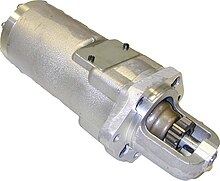
Roughly Diesel engines from six to 16 cylinders are started by means of a hydraulic motor. Hydraulic starters and the associated systems leave a sparkless, reliable method of engine start over a all-encompassing temperature wander.[11] Typically hydraulic starters are found in applications so much as remote generators, lifeboat propulsion engines, sea fire pumping engines, and hydraulic fracturing rigs. The system utilized to support the hydraulic starter includes valves, pumps, filters, a artificial lake, and piston accumulators. The operator can manually recharge the hydraulic system; this cannot readily be done with electric starting systems, so hydraulic starting systems are favored in applications wherein emergency starting is a necessity.
With assorted configurations, Hydraulic starters can be fitted on any railway locomotive. Hydraulic starters employ the high efficiency of the axial piston motor construct, which provides high torque at some temperature or environment, and guarantees negligible tire out of the engine ring cogwheel and the pinion.[12]
Non-motor [edit]
Spring starting motor [edit]

A spring starter uses potential difference energy stored in a spring wound finished with a crank up to start an engine without a battery or alternator. Turning the trash moves the pinion into interlock with the engine's ring gear, so winds up the take shape. Pulling the release lever then applies the spring tension to the pinion, turning the band gear to start the locomotive engine. The quill feather mechanically disengages from the flywheel after operation. Provision is also made to allow the railway locomotive to be slowly turned over away hand for engine maintenance. This is achieved by operating the trip lever antitrust after the pinion has engaged with the flywheel. Subsequent turning of the winding address during this military operation will non load up the starter. Spring starters force out be found in engine-generators, hydraulic power packs, and on lifeboat engines, with the just about common application being accompaniment starting organisation on seagoing vessels.
Fuel-opening [redact]
Whatever modern petrol engines with twelve operating theatre more cylinders forever have got at to the lowest degree one operating theatre more pistons at the beginning of its magnate stroking and are able to start away injecting fuel into that cylinder and igniting information technology. If the engine is stopped at the correct position, the procedure can embody applied to engines with fewer cylinders. It is uncomparable fashio of start an engine of a car with stop-start system.[13]
See also [edit]
- Aircraft engine starter
- Coffman starter
- Flame-start system
- Hucks fledgling
- Hybrid Synergy Drive
- Vincent Hugo Bendix
References [edit out]
- ^ Gingell, Rachel (8 December 2016). "The John Deere 720 diesel and its innovative pony motor invention". Farms.com. Retrieved 28 March on 2021.
- ^ Georgano, G.N. (1985). Cars 1886–1930. Beekman House. ISBN9781855019263.
- ^ "Evident Nary 745 157" (PDF).
- ^ a b "Olympia Motor Show". The Automotor Diary: 1402–1412. 23 November 1912.
- ^ Whittacker, Wayne (April 1949). "Chrysler Family Introduction". Popular Mechanism. 91 (4): 122. Retrieved 25 May 2015.
- ^ Sanders, Ralph W. (1996). Vintage farm tractors: the ultimate tribute to classic tractors. p. 98. ISBN9780896582804 . Retrieved 25 May 2015.
- ^ R. Howell, Benito (17 August 2017). "Permanent Magnet Generators for Rudolf Christian Karl Diesel Engines". PM Generators. Retrieved 14 January 2021.
- ^ "Know Your Car's Nervous Organization - Starters". Popular Mechanism. 96 (6): 186–189. June 1952. Retrieved 25 May 2015.
- ^ The 1962 Starting Drive and Alternator, Chrysler Corporation, November 1961
- ^ LaChance, David (June 2007). "Memorable Mirada". Hemmings Classic Car . Retrieved 25 May 2015.
...the twitterings of the Mountainous Park hummingbird, Mopar's famous gear wheel-reduction newcomer...
- ^ "Engine and turbine starters" (PDF). Fspowercontrol.com. Archived from the original (PDF) happening 30 Crataegus laevigata 2013.
- ^ "Hydraulic Starting Systems". Huegli-tech.com. Retrieved 25 May 2015.
- ^ "Idleness Barricade Engineering". Mazda.com. Retrieved 30 November 2015.
External links [edit]
Patents [delete]
- U.S. Patent 745,157, Clyde J. Coleman
- U.S. Manifest 1,050,739, R. C. Hull
- U.S. Patent of invention 1,464,714, Arthur Atwater Rockwell Kent
what causes high current draw in a starter motor
Source: https://en.wikipedia.org/wiki/Starter_(engine)
Posting Komentar